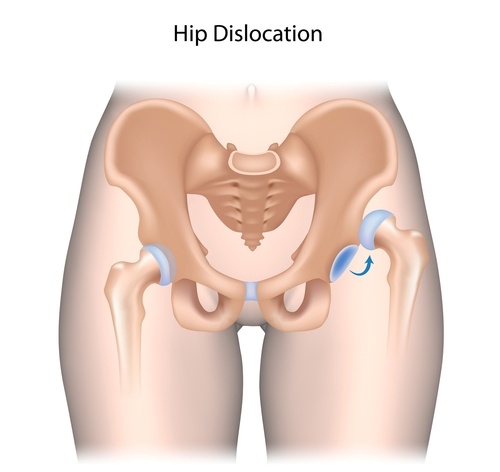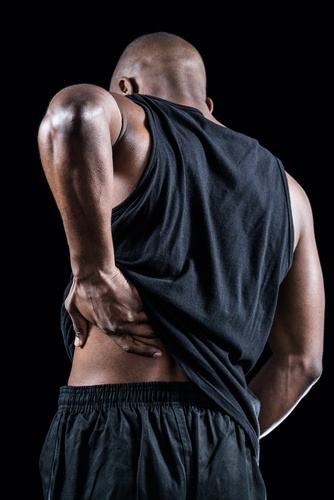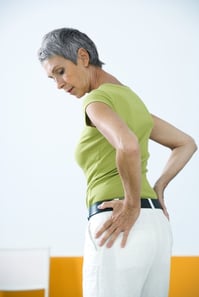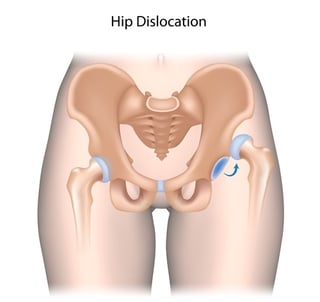Hip Pain: Causes, Treatment, and Prevention
March 21st, 2016 | 5 min. read

 When you have pain in your hip, it may be due to a problem in the joint itself. However, sometimes hip pain does not originate in the hip at all, but in other parts of the body which radiate, or refer, pain to the hip area. These areas include the ligaments, muscles, tendons, bones, joints, and other tissues surrounding the hip.
When you have pain in your hip, it may be due to a problem in the joint itself. However, sometimes hip pain does not originate in the hip at all, but in other parts of the body which radiate, or refer, pain to the hip area. These areas include the ligaments, muscles, tendons, bones, joints, and other tissues surrounding the hip.
The space that houses the hip is called the acetabulum. It is an open area holding a small amount of fluid to allow the top of the thigh bone (the femur) to glide about in the socket without friction.
The cartilage along the head of the femur (the femoral head), as well as the tough rim of the acetabulum, called the labrum, are designed to allow for flexibility and movement.
However, these areas of cartilage are subject to aging’s wear and tear or could be injured, leading to pain.
If you experience an injury to the hip or any of its surrounding tissues, inflammation can set in. This can lead to the collection of fluid or blood in the acetabulum or the stretching of the lining of the hip capsule, with pain as a result.
Hip Pain Causes 
Diseases that cause hip pain
In all cases, inflammation is a major factor. Pain is a symptom, along with redness, swelling, and a warm sensation. Any illness or disease originating in the hip region can become a source of pain.
-
Arthritis: The gradual wearing down of the hip joint’s tissues can lead to degeneration of the cartilage there, with arthritis as a result.
-
Avascular necrosis: People using long courses of corticosteroids such as prednisone risk losing their blood supply to the femoral head; when this happens, the tissue weakens and pain occurs.
-
Bursitis: Large sacs of fluid (bursae) surround the hip areas; pain signifies inflammation to these areas.
-
Cancer: Because of the eroding side effect of cancer treatments, or due to the thinning of bones that might be the result of cancer, pain can be troubling in the hip.
-
Legg-Calve-Perthes disease: This is the pediatric version of avascular necrosis; it occurs in children between the ages of 4 and 8.
-
Osteomyelitis: This is a blood- or tissue-borne bone infection that causes bone death.
-
Osteoporosis: When new bone does not replace old bone quickly enough, degeneration of the existing bones can lead to brittleness, fractures, and breaks.
Injuries that cause hip pain
-
Hip dislocation: Any kind
 of trauma can lead to the dislocation of the femur bone from its place in the acetabulum, leading to major discomfort and pain.
of trauma can lead to the dislocation of the femur bone from its place in the acetabulum, leading to major discomfort and pain. -
Hip fracture: This is the bane of the elderly and those who suffer from osteoporosis.
It takes just one bad fall to crack or break the bones around the hip, which leads to severe pain.
Most hip fractures are actually fractures of the femur; only in cases of trauma (such as a serious car accident) does actual fracturing of the acetabulum occur. -
Inflammation from general trauma: Pain is a symptom of inflammation, along with redness, swelling, and a warm sensation. Any kind of blunt force against the body can be the source of inflammation leading to hip pain
-
Labral tear of the hip: While participating in certain kinds of sports, a person risks tearing the labrum. This tough rim of the hip joint can also tear due to structural problems.
-
Pinched nerves: In particular, the sciatic nerve, at the lower end of the spinal cord, can become pinched and lead to hip pain. Other nerves may also become pinched, such as the lateral femoral cutaneous nerve in the thigh—a problem of inflammation for some pregnant women—and herniation of the inguinal or femoral nerve.
-
Referred pain: When trauma in other parts of the body (such as the lower back or knees) radiates pain, this can be felt in the hip. For instance, the iliotibial band—the tissue that connects the pelvis to the knee by way of the outside of the thigh—can cause pain in either the knee, the hip, or both areas.
-
Sprains or strains: Sprains refer to damage to the ligaments around the hip area; damage to the muscles and tendons here are called strains.
-
Tendonitis: Irritation of the thick cords that connect muscle to bone. Overuse of the tendons around the hips can cause serious inflammation. Eventual rupturing of these tendons is also a concern.
Hip pain treatment
For minor hip pain 
Here are some tried-and-true helps for managing low-level hip pain.
-
Ice or heat. Cold packs applied, wrapped in a towel, against your hip can help. The opposite—a warm bath or shower or warm compress—may also offer some relief.
-
Mild exercise. It seems counterintuitive, but mild stretching and movement can help relieve pain and improve circulation to the hip area.
-
Pain relievers. These classic drugstore solutions can help ease hip pain: acetaminophen, ibuprofen, and naproxen sodium.
-
Rest. Give your sore hip a break by letting it relax. Try to avoid putting pressure on it. Don’t sit for a long time, and when you lie down, do so on the hip that’s not sore.
-
Weight loss. If you recently gained a little weight (5 to 10 pounds), it might be worth it to try to shed those extra pounds. Added weight places a burden on our joints, especially the ones that help us move around: the joints of the hips, legs, knees, and feet. Even just a little weight loss can bring relief.
 For acute hip pain
For acute hip pain
In all of these cases, the best solution is to seek professional medical attention.
-
A joint that appears deformed may be dislocated.
-
Inability to move your leg or hip could be caused by any number of things.
-
Inability to bear weight on the affected leg is a sign that something is wrong.
-
Intense pain is always an indicator that you need to seek medical help.
-
Sudden swelling suggests inflammation caused by an injury or other internal insult.
For problems which have resulted in degeneration or breakage of the hip bones, a surgical replacement procedure may be necessary to regain mobility and eliminate chronic pain.
Hip pain prevention
Safe and regular exercise, healthy weight management, and a bone-building diet can go a long way to preventing hip pain for years to come. Check out these tips for healthy, happy hips!
-
Move the hip joint with gentle stretches, easy aerobic exercise, aquatic therapy, or mild resistance training to improve circulation and mobility. These can help prevent pain that’s caused by arthritis or overuse.
-
Physical therapy for preexisting injuries or damage to the joints can keep hips in working order.
-
Don’t ignore minor injuries. Treat them so they don’t become major injuries, which can lead to hip pain down the road.
-
For those working at a desk job, switching up your posture by changing chairs, standing while you work, or taking frequent walking or stretching breaks can help the onset of hip pain.
-
Stretch before brisk exercise to ensure the joints are loose, your blood and joint fluids are circulating, and the connective tissues are warm and elastic. Don’t forget to cool down afterward.
-
Listen to your body. If you experience pain in your joints, you might be overdoing it. Take a break to stretch and check in with your joints and muscles.
-
Wear appropriate shoes to cut down on stress not only to the feet, but to the ankles and knees, which can lead to hip problems. Avoid exercising on hard, unforgiving surfaces as well.

-
Lose a few pounds; excessive weight puts pressure on the joints, making them less flexible.
-
Rest adequately after periods of exercise to allow your joints and tissues complete recovery.
-
Eat a healthy diet to ensure you are building strong bones.
-
Regular exercise helps keeps the muscles strong and improves circulation to all of the tissues; when muscles and tissues are flexible and strong, they are less likely to be injured.
-
If you need additional help with walking, don’t ignore your options. Canes, walkers, crutches, and other assistive devices are meant to help you maintain good posture, which is essential for avoiding pain in the back, neck, and hips.
Coastal Orthopedics know all about hips and hip pain. We understand that injuries happen, but they do not have to stand in your way. Please allow us to help with identifying and treating, or even preventing, your hip pain. Call us today in Corpus Christi at (361) 248-1253.
Article written by: Rob Williams, MD
Dr. Williams has been practicing orthopedic surgery in Corpus Christi since 1998. After graduating from Texas Tech hereceived his medical degree from the University of Texas at San Antonio. At the prestigious Campbell Clinic located at the University of Tennessee, Dr. Williams completed not only an Orthopedic Surgery Residency, but an additional year of Fellowship Training in Spine Surgery. Dr. Williams is dedicated to creating an excellent patient experience in the office or in the surgery suite.

